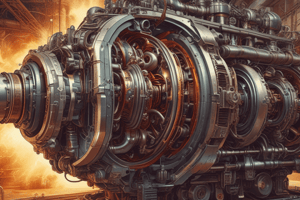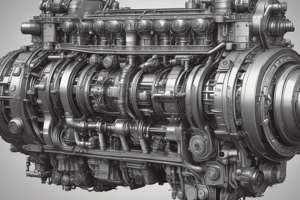Podcast
Questions and Answers
What is the primary function of a heat engine?
What is the primary function of a heat engine?
- To convert mechanical energy into thermal energy
- To generate electrical energy from fuel
- To convert kinetic energy into potential energy
- To convert thermal energy into mechanical energy (correct)
What is the main difference between an internal combustion engine and an external combustion engine?
What is the main difference between an internal combustion engine and an external combustion engine?
- The power output of the engine
- The type of fuel used in the engine
- The location of the combustion process (correct)
- The design of the engine cylinder
What is the term for the combustion process that occurs when the air-fuel mixture is ignited by a spark?
What is the term for the combustion process that occurs when the air-fuel mixture is ignited by a spark?
- Constant pressure combustion
- Constant volume combustion (correct)
- Rapid explosion combustion
- Slow burning combustion
What is the advantage of internal combustion engine over external combustion engine in terms of weight and mechanical complexity?
What is the advantage of internal combustion engine over external combustion engine in terms of weight and mechanical complexity?
What is the purpose of the piston in an internal combustion engine?
What is the purpose of the piston in an internal combustion engine?
What is the term for the combustion process that occurs when fuel is injected into highly compressed heated air contained in the cylinder?
What is the term for the combustion process that occurs when fuel is injected into highly compressed heated air contained in the cylinder?
What is the advantage of internal combustion engine over external combustion engine in terms of startup and shutdown time?
What is the advantage of internal combustion engine over external combustion engine in terms of startup and shutdown time?
What is the function of the connecting rod in an internal combustion engine?
What is the function of the connecting rod in an internal combustion engine?
What is the primary function of the flywheel in an engine?
What is the primary function of the flywheel in an engine?
What is the purpose of the counter-weights and the flywheel in an engine?
What is the purpose of the counter-weights and the flywheel in an engine?
What is the material used to make the connecting rod?
What is the material used to make the connecting rod?
What is the purpose of the camshaft in an engine?
What is the purpose of the camshaft in an engine?
What is the characteristic of engine bearings?
What is the characteristic of engine bearings?
What is the function of the valves in an engine?
What is the function of the valves in an engine?
What is the recommended horsepower for a 20 hectares farm, considering a single cropping pattern?
What is the recommended horsepower for a 20 hectares farm, considering a single cropping pattern?
What is the relationship between the speed of the crankshaft and the camshaft?
What is the relationship between the speed of the crankshaft and the camshaft?
What type of engine is preferred in very hot zones and desert areas?
What type of engine is preferred in very hot zones and desert areas?
What is the typical material used to make the flywheel?
What is the typical material used to make the flywheel?
What is the primary consideration for selecting a tractor with a lower wheel base and higher ground clearance?
What is the primary consideration for selecting a tractor with a lower wheel base and higher ground clearance?
What should be considered while purchasing a tractor to minimize the running cost?
What should be considered while purchasing a tractor to minimize the running cost?
What should be consulted for guidance while selecting a tractor?
What should be consulted for guidance while selecting a tractor?
What is the primary consideration for selecting a tractor for a 25 hectares farm with adequate irrigation facilities?
What is the primary consideration for selecting a tractor for a 25 hectares farm with adequate irrigation facilities?
What should be ensured while purchasing a tractor in terms of repairing facilities?
What should be ensured while purchasing a tractor in terms of repairing facilities?
What should be considered while purchasing a tractor in terms of initial cost and resale value?
What should be considered while purchasing a tractor in terms of initial cost and resale value?
What is the primary function of a cage wheel?
What is the primary function of a cage wheel?
What is the term for the distance between the two wheels of a tractor on the same axle?
What is the term for the distance between the two wheels of a tractor on the same axle?
What is the year in which the concept of power tiller was introduced?
What is the year in which the concept of power tiller was introduced?
What is the primary difference between a mounted implement and a power tiller?
What is the primary difference between a mounted implement and a power tiller?
What is the term for the height of the lowest point of a tractor from the ground surface?
What is the term for the height of the lowest point of a tractor from the ground surface?
What is the diameter of the smallest circle described by the outermost point of a tractor?
What is the diameter of the smallest circle described by the outermost point of a tractor?
Which country is credited with the introduction of power tillers on a large scale?
Which country is credited with the introduction of power tillers on a large scale?
What is the term for the horizontal distance between the front and rear wheels of a tractor?
What is the term for the horizontal distance between the front and rear wheels of a tractor?
What is the primary function of the decompression lever on a tractor's control board?
What is the primary function of the decompression lever on a tractor's control board?
What is the significance of the ply rating of a tractor tyre?
What is the significance of the ply rating of a tractor tyre?
What is the purpose of the front axle on a tractor?
What is the purpose of the front axle on a tractor?
What is the characteristic of a semi-mounted type implement?
What is the characteristic of a semi-mounted type implement?
What is the typical useful life of a pneumatic tractor tyre under normal operating conditions?
What is the typical useful life of a pneumatic tractor tyre under normal operating conditions?
What is the function of the hitching system in tractor-drawn implements?
What is the function of the hitching system in tractor-drawn implements?
What is the significance of the tyre size 12—38 on a tractor?
What is the significance of the tyre size 12—38 on a tractor?
What is the difference between the inflation pressure of the rear wheels and the front wheel of a tractor?
What is the difference between the inflation pressure of the rear wheels and the front wheel of a tractor?
Flashcards are hidden until you start studying
Study Notes
Principles of Internal Combustion Engine
- A heat engine is a machine that converts heat into useful work by burning fuel.
- There are two types of heat engines: external combustion engines and internal combustion engines.
- In an external combustion engine, the combustion of fuel takes place outside the cylinder, and the heat is generated in a boiler.
- In an internal combustion engine, the combustion of fuel takes place inside the cylinder, and the heat is generated within the cylinder.
- The internal combustion engine uses the expansive force of gases produced by burning fuel within the cylinder to convert the generated heat into useful power.
Types of Combustion in Internal Combustion Engine
- There are two ways combustion takes place within the cylinder:
- Constant Volume Combustion (CVC): rapid explosion of the air-fuel mixture within the cylinder, ignited by a spark.
- Constant Pressure Combustion (CPC): slow burning of fuel injected into highly compressed heated air contained in the cylinder.
Advantages of Internal Combustion Engine
- More mechanical simplicity and lower weight/power ratio.
- No need for auxiliary equipment, such as boiler and condenser.
- Can be started and stopped in a short time.
Components of Internal Combustion Engine
- Connecting Rod: made of drop-forged steel, with an I-beam type section, connecting the piston to the crankshaft.
- Crankshaft: connected to the piston through the connecting rod, converts the linear motion of the piston into the rotational motion of the flywheel.
- Engine Bearings: anti-friction bearings that support the crankshaft and camshaft, capable of withstanding high speed, heavy load, and high temperatures.
- Valves: allow air to enter the cylinder and exhaust gases to escape, operated by the camshaft.
- Camshaft: operates the valves, with separate cams for the inlet and exhaust valves, driven by the crankshaft.
- Flywheel: maintains uniform engine speed by carrying the crankshaft through the intervals when it is not receiving power from a piston.
Selection of Tractor
- Factors to consider when selecting a tractor:
- Land holding: 1 hp for every 1 hectare of land.
- Cropping pattern: less than 1.0 hectare/hp for multiple crops.
- Soil condition: tractor with less wheel base, higher ground clearance, and low overall weight for lighter soil.
- Climatic condition: air-cooled engines for hot and high-altitude areas.
- Repairing facilities: availability of dealer with technical skills for repair and maintenance.
- Running cost: tractors with less specific fuel consumption.
- Initial cost and resale value: consider the resale value and initial cost.
Control Board or Dash Board of a Tractor
- Components of the control board:
- Main switch
- Throttle lever
- Decompression lever
- Hour meter
- Light switch
- Horn button
- Battery charging indicator
- Oil pressure indicator
- Water temperature gauge
Tractor Tyres and Front Axle
- Tyres: available in many sizes with ply ratings, indicating comparative strength.
- Front axle: unit on which front wheels are mounted, comprising idler wheels for steering.
Hitching System of Tractor Drawn Implements
- Types of tractor-drawn implements:
- Trailed type: pulled and guided from a single hitch point.
- Semi-mounted type: attached to the tractor along a hinge axis.
- Mounted type: attached to the tractor, controlled directly by the tractor steering unit.
Important Terms Connected with Tractors
- Wheelbase: horizontal distance between the front and rear wheels.
- Ground clearance: height of the lowest point of the tractor from the ground surface.
- Track: distance between the two wheels of the tractor on the same axle.
- Turning space: diameter of the smallest circle described by the outermost point of the tractor.
- Cage wheel: wheel or attachment with spaced cross bars for improving traction in wet fields.
Power Tiller
- A prime mover controlled by an operator walking behind it.
- Also known as a hand tractor or walking-type tractor.
- Originated in Japan in the 1920s, with the first successful model designed in 1947.
- Power tiller is a single-axle walking-type tractor, with an optional riding seat.
Studying That Suits You
Use AI to generate personalized quizzes and flashcards to suit your learning preferences.





